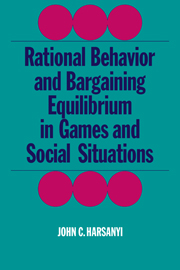Book contents
- Frontmatter
- Contents
- Preface
- Part 1 Preliminaries
- Part II General principles
- Part III Solutions for specific classes of games
- 8 Two-person simple bargaining games: the Nash solution
- 9 General two-person cooperative games
- 10 n-Person simple bargaining games
- 11 n-Person cooperative games with transferable utility: the modified Shapley value
- 12 n-Person cooperative games: the general case
- 13 n-Person cooperative games: discriminatory solutions
- 14 Noncooperative and almost-noncooperative games
- 15 Conclusion
- Notes
- References
- Index
14 - Noncooperative and almost-noncooperative games
Published online by Cambridge University Press: 24 November 2009
- Frontmatter
- Contents
- Preface
- Part 1 Preliminaries
- Part II General principles
- Part III Solutions for specific classes of games
- 8 Two-person simple bargaining games: the Nash solution
- 9 General two-person cooperative games
- 10 n-Person simple bargaining games
- 11 n-Person cooperative games with transferable utility: the modified Shapley value
- 12 n-Person cooperative games: the general case
- 13 n-Person cooperative games: discriminatory solutions
- 14 Noncooperative and almost-noncooperative games
- 15 Conclusion
- Notes
- References
- Index
Summary
Introduction
In this chapter we will define a solution for noncooperative and for almost-noncooperative games (both two-person and n-person). In Section 5.17, we defined a (strictly) noncooperative game as a game in which no agreement between the players has any binding force: Thus any player is free to violate any agreement even if he obtains no positive benefit by doing so. In contrast, we defined an almost-noncooperative game as a game in which the players are bound by any agreement that they are making as long as they cannot obtain any positive benefit by violating it, though they are free to disregard any agreement if they can achieve a positive gain (however small) by doing so.
Accordingly, whereas in a cooperative game any possible strategy n-tuple (and any possible probability mixture of such strategy n-tuples) will be stable once the players have agreed to adopt it, in a noncooperative or almost-noncooperative game only strategy n-tuples satisfying certain special stability requirements – which we call eligible-strategy n-tuples – have sufficient stability to be used by rational players. A strategy n-tuple can be eligible only if it is an equilibrium point or a maximin point (see Sections 5.12 and 5.13). As we have argued, in a strictly noncooperative game a profitable equilibrium point will be eligible only if it is a strong equilibrium point or a centroid equilibrium point, while in an almost-noncooperative game a profitable equilibrium point is always eligible.
- Type
- Chapter
- Information
- Publisher: Cambridge University PressPrint publication year: 1977



